
Cordylanthus tenuis is a species of flowering plant in the family Orobanchaceae known by the common name slender bird's beak. It is native to the US states of California, Oregon, and Nevada, where it grows in woodland and forest. It erects a spindly stem which may exceed a meter in height with sparse narrow leaves a few centimeters long, and is sometimes sticky with glandular secretions. The plant is greenish and tinted with yellow or purple coloration. The stem branches at intervals and at the end of each branch is a cluster of one to several flowers. Each pocket-shaped flower is one to two centimeters long and about one wide, made up of fuzzy maroon lobes with white or yellow lips.
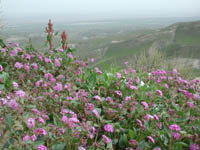
Abronia pogonantha is a species of flowering plant in the four o'clock family (Nyctaginaceae) known by the common name Mojave sand-verbena. It is native to California and Nevada, where it grows in the Mojave Desert, adjacent hills and mountains, and parts of the San Joaquin Valley in the Central Valley.
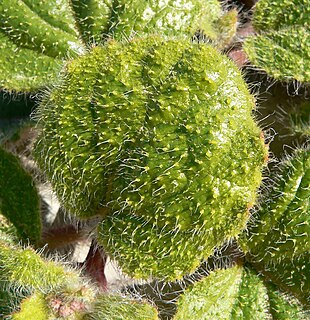
Anulocaulis annulatus is a species of flowering plant in the four o'clock family known by the common name valley ringstem. It is endemic to the Mojave Desert of California, especially in the vicinity of Death Valley. This is a perennial herb growing a number of thin, erect stems sometimes exceeding a meter in height from a thick caudex.

Calycadenia multiglandulosa is a species of flowering plant in the family Asteraceae, known by the common names sticky calycadenia and sticky western rosinweed. It is endemic to California, where it is a common in the Coast Ranges and in the Sierra Nevada Foothills from Shasta County to Kern County.

Phacelia viscida is a species of phacelia known by the common names sticky phacelia and tacky phacelia.

Pyrrocoma lucida is a species of flowering plant in the family Asteraceae known by the common names sticky goldenweed and sticky pyrrocoma. It is endemic to California, where it is known only from the northern Sierra Nevada. It grows in mountain forests and clay flats with alkali soils. This is a perennial herb growing from a taproot, producing an erect stem up to 75 centimetres (30 in) tall. It is hairless and glandular, its surface resinous and shiny. The leaves are lance-shaped with sharply toothed edges, the largest near the base of the stem reaching 25 centimetres (10 in) in length. Smaller leaves up to 10 centimetres (4 in) long occur higher on the stem. The inflorescence is a narrow spikelike array of many flower heads lined with thick, overlapping, gland-dotted phyllaries. Each head contains up to 40 yellow disc florets surrounded by a fringe of up to 20 yellow ray florets. The fruit is an achene up to a centimeter long including its pappus.

Ribes velutinum is a species of currant known by the common name desert gooseberry.
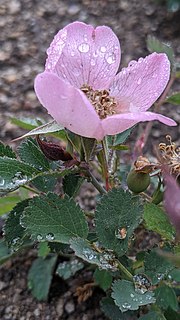
Rosa bridgesii is a species of rose known by the common names pygmy rose and Sierran dwarf rose. It is native to California, where it grows in the forests of the Sierra Nevada and surrounding mountains and foothills. It may also occur in Oregon.

Acleisanthes nevadensis is a species of flowering plant in the four o'clock family known by the common names desert moonpod and desert wing-fruit. It is native to a section of the southwestern United States encompassing southern Nevada and adjacent corners of Utah and Arizona. One occurrence has been observed in eastern California. The plant grows in desert habitat such as scrub and rocky washes. This herb produces several spreading stems up to about 30 centimeters in maximum length, sometimes from a woody base. The stems are covered in many leaves with fleshy oval or rounded blades up to 3 centimeters long which are borne on petioles. The herbage of the plant is coated in thick, wide, white, furry hairs, interspersed with shorter, flat hairs. Some hairs are glandular. Flowers occur in leaf axils. Each is a trumpet-shaped bloom with a narrow, tubular green throat up to 4 centimeters long and a round white corolla face about a centimeter wide, sometimes tinged yellow or greenish. There are five long, protruding stamens and a long style tipped with a spherical stigma. The fruit is a ribbed, hairy body with five broad, white wings.

Silene bernardina is a species of flowering plant in the family Caryophyllaceae known by the common name Palmer's catchfly.
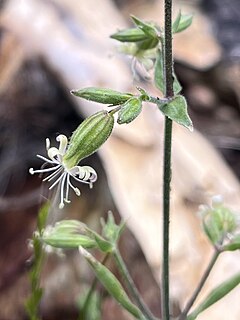
Silene bridgesii is a species of flowering plant in the family Caryophyllaceae known by the common name Bridges' catchfly. It is native to California, where it can be found throughout the Sierra Nevada and the southern reaches of the Cascade Range to the north, its distribution possibly extending into Oregon. It grows in mountain forests and woodlands. It is a perennial herb growing from a taproot and woody caudex unit, its stem decumbent or growing erect to half a meter or more in height. It is hairy, the upper hairs glandular, making the plant sticky in texture. The lower leaves are widely lance-shaped, up to 8 centimeters long by 1.5 wide. Upper leaves are smaller. Flowers occur in a terminal cyme at the top of the stem, as well as in some of the leaf axils, where they nod or hang like a bell. Each has a hairy, glandular calyx of fused sepals with ten veins. The calyx is open at the tip, revealing five white, pinkish, or greenish petals each with two rectangular lobes at the tip. The very long stamens and three styles protrude from the flower's center.

Silene campanulata is a species of flowering plant in the family Caryophyllaceae known by the common names Red Mountain catchfly and bell catchfly. It may be a synonym of Silene greenei.

Silene noctiflora is a species of flowering plant in the family Caryophyllaceae known by the common names night-flowering catchfly, nightflowering silene and clammy cockle. It is native to Eurasia, but it is known on other continents as an introduced species and sometimes a weed. In North America, it is a common weed of grain crops in the Canadian prairie provinces and in much of the United States. It grows in fields and in other disturbed habitat.
Silene nuda is a species of flowering plant in the family Caryophyllaceae known by the common names western fringed catchfly and sticky catchfly.

Spergularia macrotheca is a species of flowering plant in the family Caryophyllaceae known by the common name sticky sandspurry. It is native to western North America from British Columbia to Baja California, where it grows in many types of moist coastal and inland habitat, often in alkaline and saline substrates. It may be found in marshes, alkali flats, beaches, meadows, seeps, and vernal pools. It is a perennial herb producing a narrow stem up to 40 centimeters long with a woody, thickened base and taproot. They may grow erect or prostrate across the ground. It is covered in sticky glandular hairs, especially in the inflorescence. The stems are lined with fleshy linear leaves, sometimes tipped with spines. The leaves are accompanied by triangular stipules up to a centimeter long each. Flowers occur in clusters at the end of the stem as well as in leaf axils. The small flowers have five pointed sepals and five oval white to lavender-pink petals. The fruit is a capsule containing tiny reddish brown, winged seeds.

Stachys chamissonis is a species of flowering plant in the mint family known by the common name coastal hedgenettle. It is a perennial herb native to the west coast of North America, where it grows in moist coastal habitat from Alaska to central California. This mint produces an erect stem 1 to 2+1⁄2 meters. It is hairy, glandular, and aromatic. The oppositely arranged leaves have pointed, wavy-edged blades up to 18 centimeters (7.1 in) long which are borne on petioles. The hairy, glandular inflorescence is made up of interrupted clusters of up to six flowers each. The flower has a deep pink tubular corolla which can be over 3 centimeters (1.2 in) long. The corollas are borne in hairy calyces of purple or purple-tinged sepals.
Stanleya elata is a species of flowering plant in the family Brassicaceae known by the common name Panamint princesplume. It is native to the desert mountains of eastern California and western Nevada, where it grows in rocky and scrubby habitat types. It may also occur in Arizona. It is a perennial herb producing one or more erect stems reaching about 1.5 meters in maximum height. They are hairless and often waxy in texture. The thick, leathery leaves have lance-shaped or oblong blades with smooth or toothed edges measuring up to 15 centimeters long. They are borne on petioles. The top of the stem is occupied by a long inflorescence which is a dense, snaking raceme of many flowers. Each flower has four narrow, threadlike yellow or whitish petals each about a centimeter long and a millimeter wide. The fruit is a long, thin, wormlike silique which may be 10 centimeters in length. It contains tiny seeds.

Trifolium obtusiflorum is a species of clover known by the common name clammy clover. It is native to California in the Peninsular, Transverse, Sierra Nevada, and the California Coast Ranges and Cascade Range into southwestern Oregon.
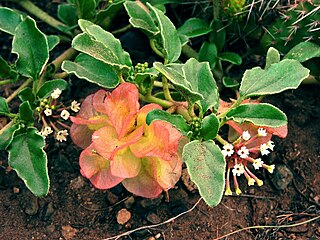
Tripterocalyx micranthus is a species of flowering plant in the four o'clock family known by the common names smallflower sandverbena and small-flowered sand-verbena.

Agnorhiza ovata is a species of flowering plant known by the common name southern mule's ears. It is native to the mountains and foothills of southern California and Baja California, occurring the Coast Ranges and Sierra Nevada foothills in Tulare, Kern, Ventura, Los Angeles, Orange, Riverside, and San Diego counties in California, with additional populations in the Peninsular Ranges south of the international border.

















